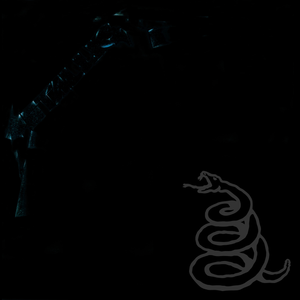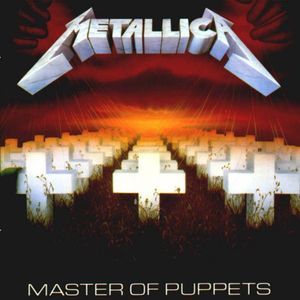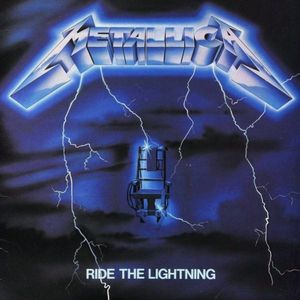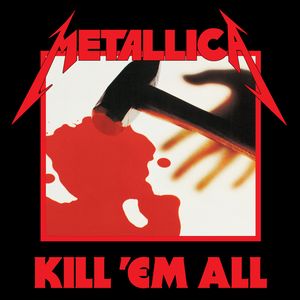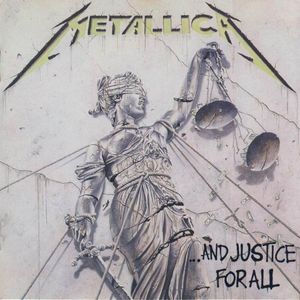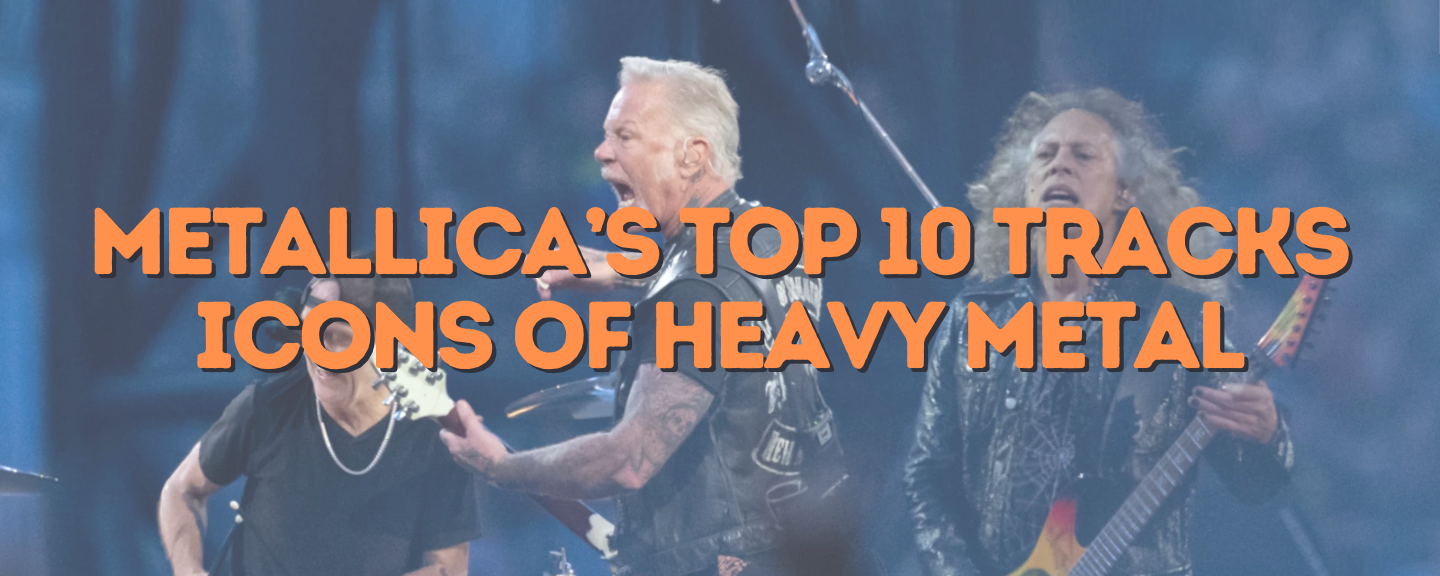
Metallica’s Top 10 Tracks: Icons of Heavy Metal
Click title to open the Spotify playlist
Metallica: The Kings of Thrash and Beyond
Metallica, the undisputed kings of thrash metal, emerged from the depths of Los Angeles in 1981. Founded by the dynamic duo of James Hetfield (vocals, guitar) and Lars Ulrich (drums), the band soon staked their claim in the Bay Area, San Francisco becoming their spiritual home.
Their blistering tempos, ferocious instrumentals, and unrelenting aggression cemented their status as one of the "Big Four" of thrash, alongside Megadeth, Anthrax, and Slayer. This quartet redefined the genre, leaving an indelible mark on heavy metal history.
Metallica's current lineup boasts the founding members Hetfield and Ulrich, alongside the legendary Kirk Hammett (lead guitar) and the powerhouse bassist Robert Trujillo. The band's history is also marked by the contributions of former members: Dave Mustaine, who went on to form Megadeth after his departure, along with bassists Ron McGovney, the late Cliff Burton, and Jason Newsted.
Their third album, Master of Puppets (1986), became a defining moment in metal history. This masterpiece, widely hailed as one of the heaviest albums ever created, solidified Metallica's status as a force to be reckoned with. Their following release, ...And Justice for All (1988), catapulted them to new heights, earning their first Grammy nomination.
The game-changing Metallica (1991) marked a turning point for the band. They embraced a more mainstream sound, capturing the hearts of a wider audience. This album shattered records, selling over 16 million copies in the United States, making it the best-selling album of the SoundScan era.
Metallica continued to explore diverse musical avenues in subsequent releases, venturing into various genres. However, they returned to their thrash roots with the powerful Death Magnetic (2008), a sonic blast that rekindled the energy of their early work.
Their most recent offering, 72 Seasons (2023), continues to showcase their unwavering commitment to pushing boundaries and delivering music that both transcends genres and honors their legacy.
Metallica's story is one of relentless passion, musical innovation, and enduring impact. They've defied expectations, navigated countless challenges, and remained true to their core sound, solidifying their position as one of the most influential and enduring bands of all time.
From the blistering thrash of “Master of Puppets” to the brooding power of “Nothing Else Matters,” Metallica has remained a driving force in heavy music for decades. In this countdown, we’ll explore ten of their most influential songs—each a testament to the band’s raw intensity, technical brilliance, and fearless evolution. Whether you’re a lifelong fan or a newcomer to the metal scene, these tracks capture the unmistakable sound and spirit that have made Metallica a global phenomenon.
Our Selection Methodology
These songs were carefully selected based on cultural impact, musical innovation, streaming popularity, and their significance in the band's discography.
🏆 Top 3 Greatest Songs
Why "Sad But True" is #1
Off the Black Album, “Sad But True” presents a slower, heavier groove that accentuates the bone-crushing potential of drop tuning. The colossal guitar tone—combined with Hetfield’s gritty vocals—creates a sonic wall that’s as menacing as it is catchy. This shift from thrash tempos to a lumbering, headbang-worthy groove helped broaden Metallica’s appeal in the 1990s, reaffirming their versatility as songwriters. Lyrically, “Sad But True” dives into themes of dark internal forces and duality, suggesting that we all harbor an inner self capable of both empowerment and destruction. Hetfield’s vocal performance underscores the push-pull of this concept, alternating between an ominous growl and a near-preaching intensity in the chorus. The song’s simplicity, as compared to their more complex thrash compositions, highlights Metallica’s skill in crafting memorable hooks without sacrificing heaviness. It remains a crowd favorite and a reminder of how the band reinvented their sound to conquer new frontiers in heavy music.
Why "Battery" is #2
Opening the Master of Puppets album, “Battery” starts with a deceptively serene acoustic intro that lasts just long enough to lull the listener—before exploding into a frenetic barrage of thrash riffs and double-bass drumming. The song pays homage to the notion of “battery” as both physical assault and the collective energy of the metal community. Its precise, machine-gun riffing highlights James Hetfield’s rhythmic tightness, while Lars Ulrich’s drumming punctuates every bar with unrelenting ferocity. Despite its breakneck pace, “Battery” is far from one-dimensional. The track spotlights subtle guitar harmonies and dynamic shifts that keep it from becoming a mere exercise in speed. Lyrically, it’s an affirmation of metal’s unifying power, hinting at how the genre and its fans stand strong against societal dismissals. This union of technical acumen, raw aggression, and unifying message encapsulates the spirit of Master of Puppets and stands as a testament to Metallica’s prowess during the peak of their thrash era.
Why "Creeping Death" is #3
Another Ride the Lightning classic, “Creeping Death” takes the biblical story of the Plagues of Egypt and recasts it as a thrash metal epic. The introductory guitar harmony and galloping riffs immediately grab the listener’s attention, setting the stage for Hetfield’s authoritative roar. The composition alternates between blazing speed and rhythmic breakdowns, capturing the chaotic and cinematic scope of the narrative. It’s a track that exemplifies Metallica’s early knack for combining literary or historical themes with blistering musicianship. What truly sets “Creeping Death” apart is the iconic crowd chant section—where fans echo the rallying cry of “Die! Die! Die!” in unison. This live staple underscores the communal energy Metallica fosters with audiences worldwide. Beyond the theatrics, the song’s lyrical portrayal of divine wrath and human suffering delves into deeper questions of faith, justice, and fate, giving “Creeping Death” a thematic heft that pairs perfectly with its relentless musical attack. It remains one of the band’s most electrifying tracks, even after decades on stage.
📊 Complete Rankings
For Whom the Bell Tolls
nspired by Ernest Hemingway’s novel, this mid-tempo track from Ride the Lightning builds an imposing atmosphere right from its bass-heavy introduction. Cliff Burton’s iconic bass intro—often mistaken for guitar—sets a somber, battle-like tone that underpins the entire composition. The song avoids the breakneck speed typical of early Metallica, instead favoring a slower, grinding groove that underscores the narrative about the brutal realities of war and the senseless loss it entails. Lyrically, “For Whom the Bell Tolls” utilizes imagery from Hemingway’s work, but it also transcends that source to comment more generally on human conflict and mortality. The marching rhythm, combined with layered guitar harmonies, paints a vivid sonic picture of a battlefield. This approach highlights Metallica’s ability to bring literary and philosophical depth to the heavy metal sphere. The track’s timeless groove and thematic resonance have solidified it as a staple in their live sets and a hallmark of their mid-80s evolution.
Nothing Else Matters
A standout from the Black Album, “Nothing Else Matters” represents Metallica’s most unabashed exploration of melodic rock and vulnerability. Composed initially as a private piece by Hetfield, it evolved into one of the band’s biggest hits. The delicate arpeggiated guitar intro establishes a contemplative tone, complemented by orchestral elements in later renditions that amplify its emotional weight. This ballad was a stark departure from their thrash roots, showcasing just how far Metallica was willing to push the boundaries of heavy music. Lyrically, the track champions personal connections and the importance of genuine relationships in an often turbulent world. Hetfield’s vocal delivery is notably raw and heartfelt, breaking from the harsh style that had come to define Metallica. While its commercial success drew criticism from some diehard thrash fans, “Nothing Else Matters” broadened the band’s fan base and proved that a group rooted in the underground could pen a universal anthem. Its continued resonance underscores the universality of its message: in the midst of chaos, personal bonds anchor us.
Seek & Destroy
Off their debut album Kill ’Em All, “Seek & Destroy” announces Metallica’s arrival on the thrash metal scene with its driving riffs, punchy drums, and an attitude brimming with youthful aggression. Influenced by the New Wave of British Heavy Metal, the track channels energy from bands like Diamond Head and Motörhead, yet forges its own identity through James Hetfield’s snarling vocals and Cliff Burton’s forceful bass presence. The instantly recognizable main riff and direct, call-to-arms chorus made it an early fan favorite. Beyond its catchy hooks, “Seek & Destroy” exemplifies the raw spirit and DIY ethic that fueled early Metallica. The recording quality might be rough around the edges, but it only adds to the track’s authenticity and punk-like energy. The live versions often extend into jam sessions, inviting crowd participation and further cementing its status as a thrash anthem. Decades after its release, the song remains a testament to the band’s ability to take the intensity of underground metal and propel it into the collective consciousness.
Fade to Black
From Ride the Lightning, “Fade to Black” stands out as Metallica’s first genuine foray into ballad territory, though it still packs plenty of metallic punch. The gentle acoustic intro ushers in a reflective mood, gradually escalating into a searing guitar solo that brims with emotion. In contrast to some of the band’s faster, thrash-oriented material, this track prioritizes mood and melody, revealing another layer to Metallica’s songwriting capabilities. The interplay between the clean verses and heavy choruses sets a dramatic tone, giving the song a dynamic, almost cinematic feel. Lyrically, “Fade to Black” tackles despair and suicidal ideation, a stark thematic departure from the typical metal bravado of its time. This level of vulnerability resonated with fans who identified with the raw honesty in Hetfield’s words. In forging this ballad, Metallica challenged the unwritten rules of thrash, proving that introspective content and softer musical passages could coexist with pounding riffs. Today, the song remains a staple of their live shows, offering a poignant moment that underscores the emotional depth at the heart of Metallica’s music.
Enter Sandman
Released as the lead single from the self-titled Black Album, “Enter Sandman” opens with a creeping guitar riff that quickly became an anthem of the early ’90s. The track’s mainstream appeal lies in its perfect blend of radio-friendly hooks and menacing atmosphere. Producer Bob Rock’s touch ensured that each component—vocals, guitars, bass, and drums—sounded massive and polished, a clear departure from the rawer production of their ’80s records. It’s a slower burn than many of Metallica’s classic thrash songs, but the groove is undeniable, and it set the stage for a new era of heavy music in the mainstream. Lyrically, “Enter Sandman” delves into themes of nightmares and the subconscious fears that plague us at night. The interplay between the lullaby-like section and Hetfield’s growling delivery underscores the idea that childhood terrors can follow us into adulthood. This thematic resonance and the song’s memorable chorus made it a fixture on radio, MTV, and in pop culture at large. While some longtime fans initially resisted the band’s shift toward a more accessible sound, “Enter Sandman” remains an iconic track that proves heavy music can captivate a massive global audience without losing its edge.
One
From …And Justice for All, “One” begins with somber arpeggios and sound effects evoking the chaos of war—subtle cues that foreshadow the onslaught to come. The song’s structure gradually builds tension, starting as a haunting ballad that highlights Metallica’s capacity for emotional depth. As it progresses, the pace quickens and the guitars become more furious, culminating in one of the most ferocious thrash passages in the band’s catalog. Kirk Hammett’s guitar solo pierces through the mix, adding a layer of desperation that complements the storyline. Lyrically, “One” takes inspiration from the novel Johnny Got His Gun, which depicts a soldier who’s lost all senses after being wounded in battle, trapped alone in his own mind. This grim narrative underscores the horrors of war and the fragility of life, making it one of Metallica’s most poignant and thought-provoking pieces. The song’s dual nature—delicate, almost mournful in the verses but explosive in the latter half—illustrates the band’s ability to marry narrative weight with musical intensity. Beyond its critical acclaim, “One” helped introduce Metallica to a broader audience, proving that even in the heavier realms of music, storytelling and artistic expression can transcend boundaries.
Master of Puppets
“Master of Puppets” is often regarded as Metallica’s defining statement—an eight-minute opus that encapsulates the technical prowess and raw intensity of mid-80s thrash. The track’s opening riff is instantly recognizable, delivering a tight, galloping rhythm that builds tension before branching into various tempo shifts and interludes. One of its standout features is the melodic bridge, where soaring harmonies take center stage, offering a moment of reflection before plunging back into the aggression. This roller-coaster songwriting approach holds the listener’s attention throughout, showcasing Metallica’s ability to blend complexity with memorability. Lyrically, “Master of Puppets” explores the theme of manipulation—particularly by substances or external forces that control one’s actions. This subject matter resonated strongly with fans, who saw it as both a cautionary tale and a rallying cry against losing autonomy. The combination of razor-sharp guitar work, relentless drumming, and James Hetfield’s powerful vocals results in a song that feels simultaneously expansive and intimate. Even decades after its release, “Master of Puppets” remains a benchmark for heavy metal excellence, regularly cited as one of the greatest metal tracks in history.
🎵 Why These Tracks Define Musical Excellence
This carefully curated ranking represents the pinnacle of Metallica’s Top 10 Tracks: Icons of Heavy Metal artistic achievement. Each song has earned its place through a combination of cultural impact, musical innovation, and enduring popularity among fans worldwide.
Cultural Impact
Songs that shaped music history and influenced countless artists
Fan Favorites
Tracks with millions of streams and lasting popularity across generations
Related Video
Last Modified: 3/12/2025

